Mediterranean Garden Ideas: Transform Your Outdoor Space with Charm
Imagine transforming your backyard into a serene, sun-soaked paradise inspired by the Mediterranean. With the right plants and design elements, you can recreate the charm of Italy, Spain, or Greece right at your doorstep. How can you make your garden an oasis of tranquility and beauty?
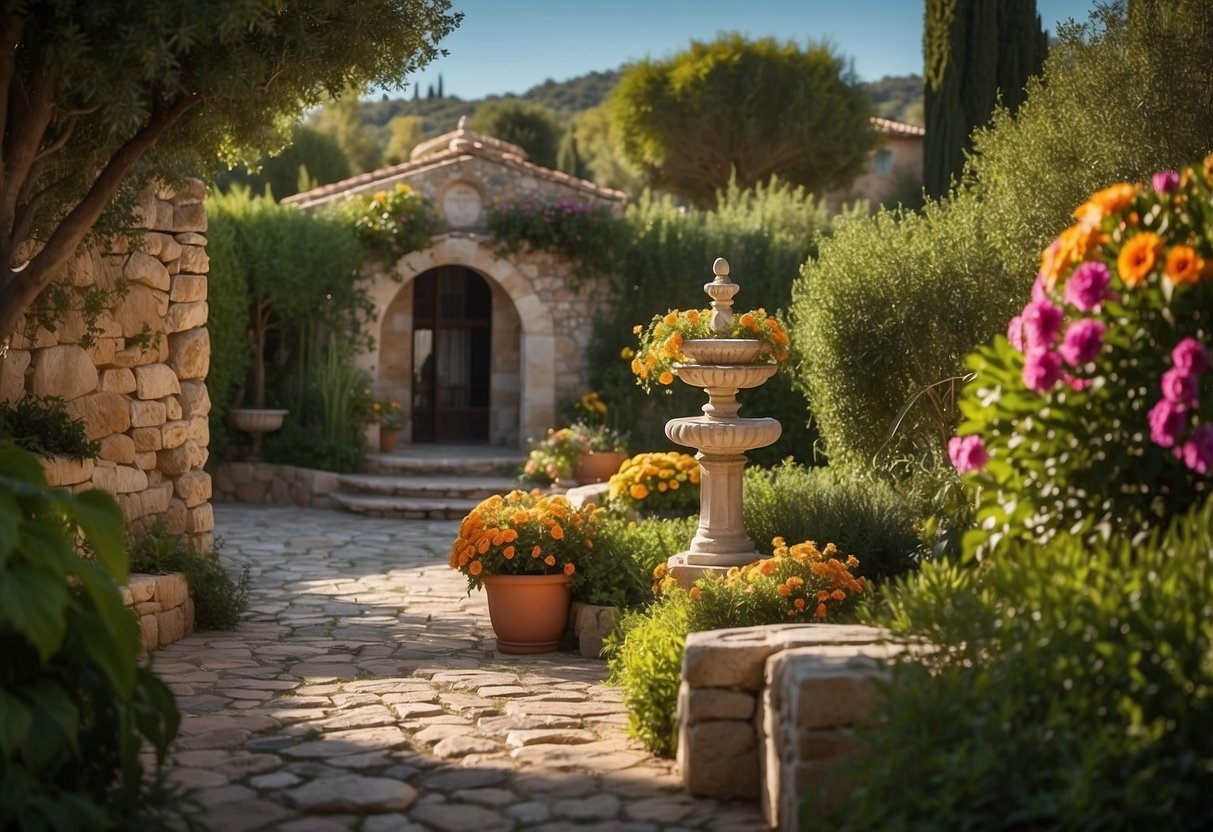
By incorporating vibrant colors, aromatic plants, and rustic materials, your garden will not only look beautiful but also thrive in dry, sunny conditions. From choosing drought-tolerant plants to creating inviting seating areas, every element plays a role in capturing the essence of a Mediterranean garden.
1) Olive Trees
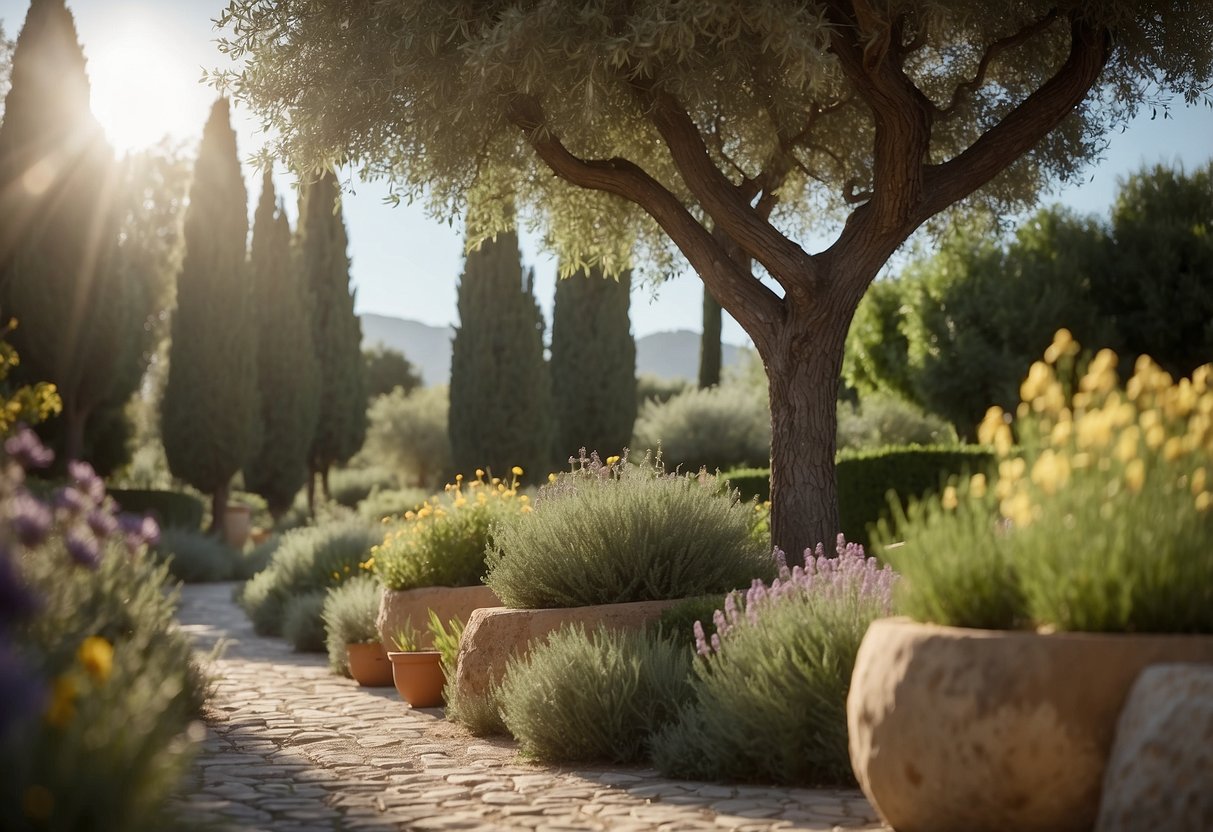
Olive trees are a staple in Mediterranean gardens. They bring a classic touch with their silver-green leaves and gnarled trunks. You can plant them in pots or directly in the ground.
These trees thrive in hot, dry climates and need minimal water. Their fruit can be harvested for olives or oil, adding both beauty and functionality to your garden. Consider placing them near seating areas for added shade and ambiance. For more ideas on incorporating olive trees, explore these Mediterranean garden ideas.
2) Lavender Bushes

Lavender bushes are perfect for a Mediterranean garden. They thrive in full sun and can handle dry conditions well. Their purple blooms add beautiful color and fragrance to your garden.
You can plant lavender next to stone walls or use them to create borders. They also look great in containers, which gives you flexibility in your garden design.
Lavender is not only a visual delight; it also attracts bees and butterflies, enhancing your garden’s biodiversity. Plus, it’s low-maintenance, making it easy to care for.
3) Terracotta Pots

Terracotta pots are a staple in Mediterranean gardens. They add an earthy, rustic charm to your outdoor space.
These pots are perfect for growing Mediterranean plants like lavender and rosemary. The warm, earthy tones of terracotta make the green leaves and colorful blooms stand out.
Terracotta pots are also durable and porous, helping to keep plants healthy by allowing air and water to flow through the soil.
If you want to know more about why terracotta pots are important, you can read more here.
4) Water Fountains

A water fountain adds charm and tranquility to your Mediterranean garden. The gentle sound of water can create a peaceful atmosphere for relaxation.
You can choose a freestanding fountain as the centerpiece of your garden. A wall fountain provides a more subtle touch. Both options bring a sense of calm and elegance.
Another great idea is to use simple stone or terracotta fountains. They blend perfectly with Mediterranean vibes and enhance the garden’s beauty. The sound of trickling water helps to cool down the space and offers a refreshing feel.
Adding fire bowls around the fountain can create a magical atmosphere at night. Fire and water together make your garden look like an enchanting escape.
For more inspiration, you can check out different Mediterranean garden ideas. This will help you visualize how water fountains can transform your garden into a serene oasis.
5) Grape Vines

Grape vines are a fantastic addition to your Mediterranean garden. They’re not only beautiful but also functional.
You can train them up walls, trellises, pergolas, and fences for a stunning effect. Their lush foliage and clusters of grapes provide lovely shade and a touch of elegance.
In cooler climates, certain varieties of grape vines can thrive. They add depth and charm to the landscape, enhancing the overall Mediterranean feel. Learn more about grape vines.
6) Stone Pathways

Stone pathways add charm and character to any Mediterranean garden. They guide visitors through the space, creating a sense of exploration.
Using natural materials like stone and terracotta enhances the rustic, weathered look typical of Mediterranean style. Stone pathways set the tone, highlighting the garden’s design.
To make your path pop, plant colorful Mediterranean plants along the edges. This provides a vibrant, welcoming atmosphere that draws people in.
7) Rustic Pergolas

You can use rustic pergolas to add charm to your Mediterranean garden. These wooden structures are great for climbing plants like grapevines and bougainvillea.
Pergolas provide shade, creating a comfortable outdoor space. They can also serve as a focal point in your garden.
For a Mediterranean feel, choose materials like aged wood to give it a timeless look.
Adding some string lights can make the space cozy for evening relaxation. Rustic pergolas are both functional and beautiful, enhancing your garden’s ambiance.
8) Herb Gardens

Herb gardens are a wonderful addition to your Mediterranean garden. They bring both beauty and functionality to your space.
Consider planting herbs like rosemary, thyme, oregano, and lavender. These plants thrive in sunny climates and need well-drained soil.
You can also grow basil and sage for a variety of textures and fragrances. Herbs like these add an aromatic touch and can be used in your cooking.
9) Bougainvillea

Bougainvillea is perfect for adding vibrant color to your Mediterranean garden. Its bright blooms pop against the lush green foliage and stonework typical of this style.
You can train bougainvillea to climb on trellises, arbors, or pergolas. This creates a stunning vertical display and adds privacy and shade.
For smaller spaces, consider using bougainvillea in hanging baskets. This brings a splash of color to patios or balconies without taking up much room.
In warm climates, bougainvillea thrives with minimal maintenance, making it a great choice for busy gardeners.
10) Succulent Beds
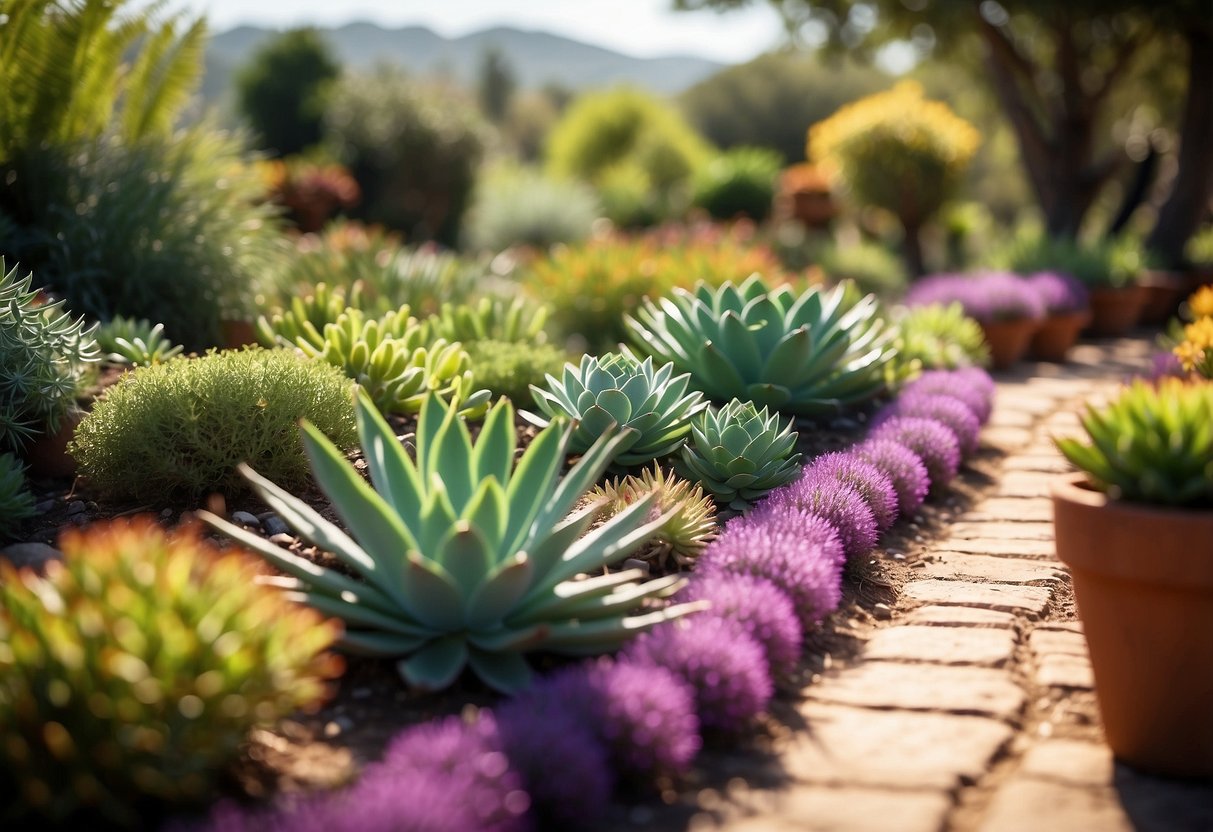
Succulents are perfect for Mediterranean gardens. They are low-maintenance and add a variety of colors and shapes. You can create a stunning garden with different types of succulents.
For example, Blue Chalksticks have silvery blue leaves that form a dense mat. Another great choice is cacti, which are hardy and need minimal water.
Plant succulents in raised beds or containers. This gives them good drainage and keeps them healthy. Use natural stones or gravels to decorate the beds, enhancing the Mediterranean feel.
Benefits of a Mediterranean Garden
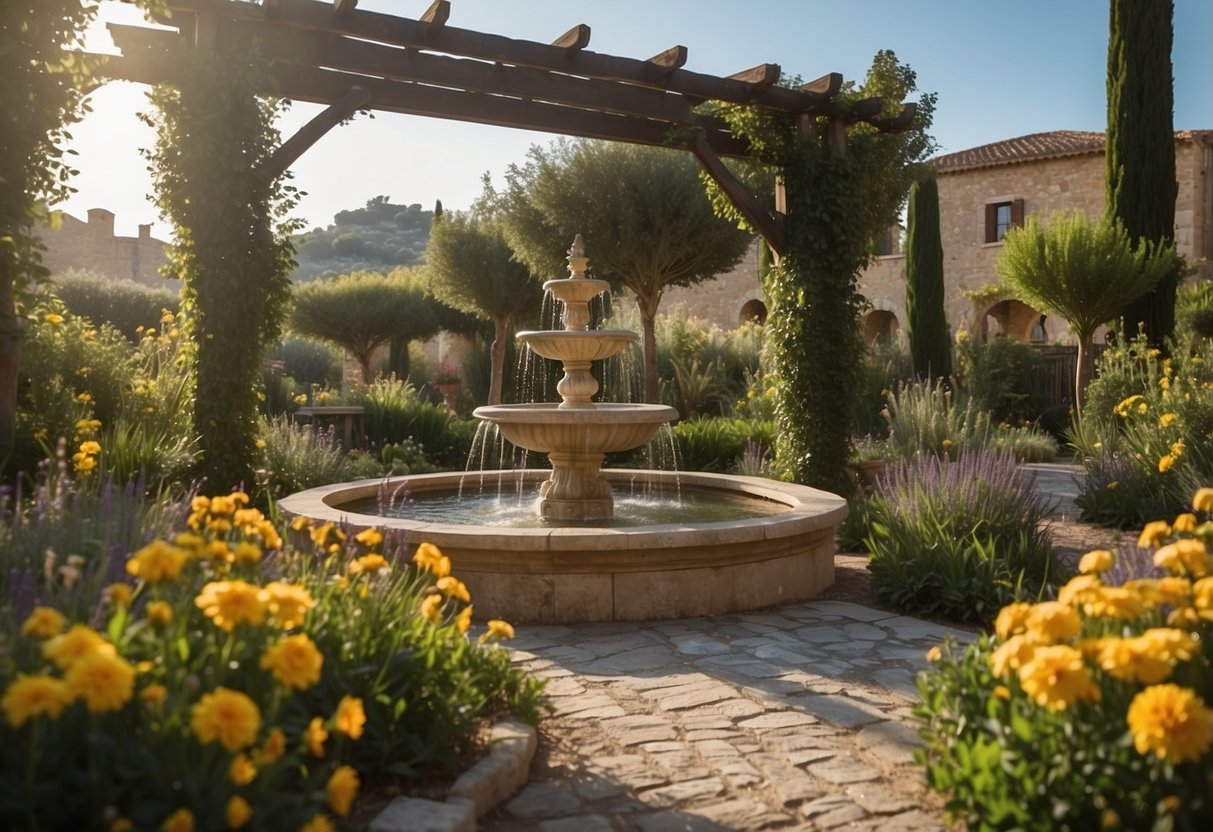
Mediterranean gardens offer many advantages, from climate adaptability to low maintenance requirements. These gardens bring beauty and practicality to your outdoor space, making them an attractive option for many homeowners.
Climate Adaptability
Mediterranean gardens are perfect for areas with hot, dry summers and cooler, wet winters. They use drought-tolerant plants like lavender, rosemary, and olive trees, which thrive in these conditions. This feature makes them an excellent choice if you live in regions with similar climates.
These plants save water, which helps you keep your garden looking great during droughts. Additionally, Mediterranean gardens often include gravel mulch that keeps soil moist and prevents weeds. This approach adds to the aesthetics and functionality of your garden.
A well-designed Mediterranean garden can withstand harsh weather changes, giving you a lasting outdoor space. Using native plants from Mediterranean regions ensures your garden remains hardy and vibrant throughout the year.
Low Maintenance Requirements
Mediterranean gardens typically need less upkeep than other garden styles. Many of the plants you’ll use are naturally pest-resistant and don’t require much watering. This means you spend less time on garden chores and more time enjoying your space.
Using hardy plants means less pruning and fertilizing. For example, olive trees and lavender grow well without much attention. The landscaping often includes elements like stone terraces and gravel paths, which reduce the need for mowing and edging.
Pollinator-friendly plants like rosemary and lavender attract beneficial insects, reducing the need for chemical pesticides. This creates a healthier garden environment for you and your local ecosystem. These low-maintenance features make Mediterranean gardens an ideal choice if you want a beautiful garden with minimal effort.
Essential Plants for Mediterranean Gardens

Mediterranean gardens are characterized by their ability to thrive in dry, sunny environments with minimal water. Choosing the right plants can create a beautiful and sustainable garden.
Drought-Resistant Plants
Drought-resistant plants are perfect for Mediterranean gardens. These plants can survive hot temperatures and need less water. Lavender is a popular choice. It has fragrant purple flowers and is very hardy.
Rosemary is another excellent option. It provides evergreen foliage and aromatic leaves that can be used in cooking. Thyme and oregano are also great picks. They are low-growing, aromatic herbs that can add both beauty and practicality to your garden.
Succulents like agave and aloe vera are also well-suited for these conditions. They store water in their leaves, making them ideal for dry climates. Use them to add texture and interest to your garden beds.
Native Mediterranean Flora
Including native Mediterranean plants will make your garden look authentic. Olive trees are iconic. They are tough, can live for many years, and their silver-grey leaves add a lovely touch.
Cypress trees are another staple. They can grow tall and provide a striking vertical element. Bougainvillea is a vibrant climber that produces stunning, colorful flowers. It can cover walls and fences, adding a splash of color.
Lavender cotton (Santolina) has silvery foliage and yellow button flowers, which are perfect for creating soft mounds in your garden.
Rockrose (Cistus) blooms in a variety of colors and thrives in poor soil, providing beautiful ground cover options.
Using these plants helps to create a garden that is both beautiful and suited to the Mediterranean climate. Embrace these varieties and enjoy a lush, low-maintenance garden.
Design Elements to Consider
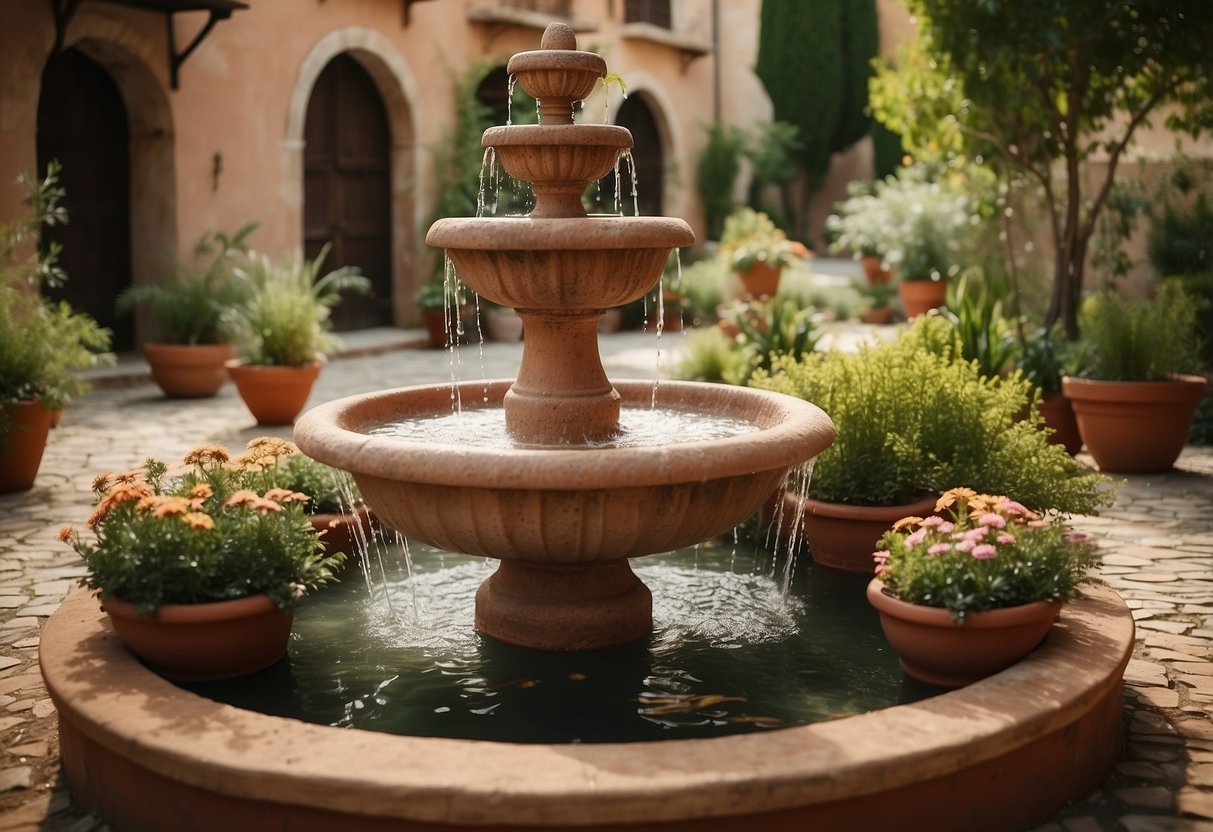
When creating a Mediterranean garden, it’s important to focus on natural materials and water features. These elements not only enhance the beauty of your garden but also create a relaxing atmosphere.
Use of Natural Materials
Using natural materials is a key aspect of Mediterranean garden design. Consider using stones, gravel, and terracotta in your paths and seating areas. These materials are not just aesthetically pleasing but also practical. For example, pale-colored gravel and tile in sun-washed shades like terracotta offer both functionality and a neutral palette.
You can also build terraces using locally sourced stones. This adds an eco-friendly touch to your garden. Terraces can help create different levels, making your garden look larger and more interesting. Plus, natural stone is durable and lasts a lifetime.
Incorporating Water Features
Water features add a sense of tranquility to a Mediterranean garden. A small pond or fountain can be a great focal point. Incorporate features like a small, tiled fountain to instantly transport you to a Mediterranean villa. The sound of trickling water adds to the relaxing atmosphere.
You might also consider a reflecting pool. These pools, often framed with natural stones, can reflect the beauty of surrounding plants and trees. Adding aquatic plants can further enhance the look, creating a balanced and serene environment.
Including a birdbath made of stone or terracotta could also attract local wildlife, adding life and movement to your garden.







